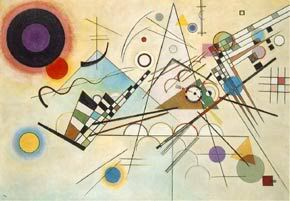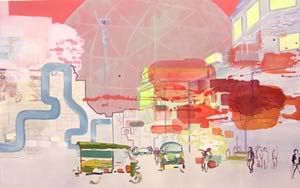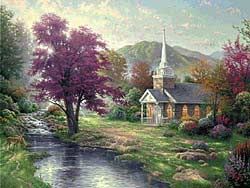The Evangelical Outpost Blog has a very interesting post on famous Christian artist Thomas Kinkade.
While browsing through the links (and further comments) this post describes what I've identified as the problem with imagined space.
There is a new crop of painters who use a variety of images, many of which they don't draw or paint 100% (I suspect there is a lot of tracing going on and that copy machines and computer downloads are quite active), to create these non-existent places.
I think Kandinsky was aiming for such non-existent places in his vaguely familiar, abstracted paintings. They remind us of something (an animal, a plant, a city?) but we're at a loss to say what.

Kandinsky, Compostition VIII, 1923
Of course, these artists forfeit the long-established perspective drawings, proportions, realistic colorings, and even coherent themes and stories in order to bring us their utopias (or dystopias).

Kristine Moran, Checkpoint, 2005
From a commenter called 'Lizzie' on Kindade's art posted at Hollywood Jesus News Blog:
| At first glance, [Kinkade's]subjects look well drawn, realistically rendered, and believably three-dimensional--what one would expect from any art school graduate…I found misaligned perspectives, awkward proportions, inexplicable light sources, and strange juxtapositions of architecture and landscape. His scenery has no relationship to geographical reality…His churches are buried in deep forests and hover at the edge of swamps, without paths, their front doors, blocked by streams that in any remotely real geography would immediately flood the buildings… I find it especially telling in the painting of the nature churches, where there seems to be no way for any human to access the church itself. One is cut off by dense forests, giant mountains, and rivers… Where people are depicted they are awkward, stick-like and blurred: unspecific, faceless figures, barely three dimensional and lacking the color, depth, weight, movement, that he gives inanimate objects…Professional artists spend years trying to capture the human body... In almost all of his paintings the parts do not fit together naturally… This general mismatching is patched over with the stippled points of light and deliberately brilliant colors to create an artificially uniform effect. |

Thomas Kinkade, Streams of Living Water
Now, an interesting question would be: "Why would a 'Christian' artist spend so much time creating his utopia (heaven, paradise?) on earth?"